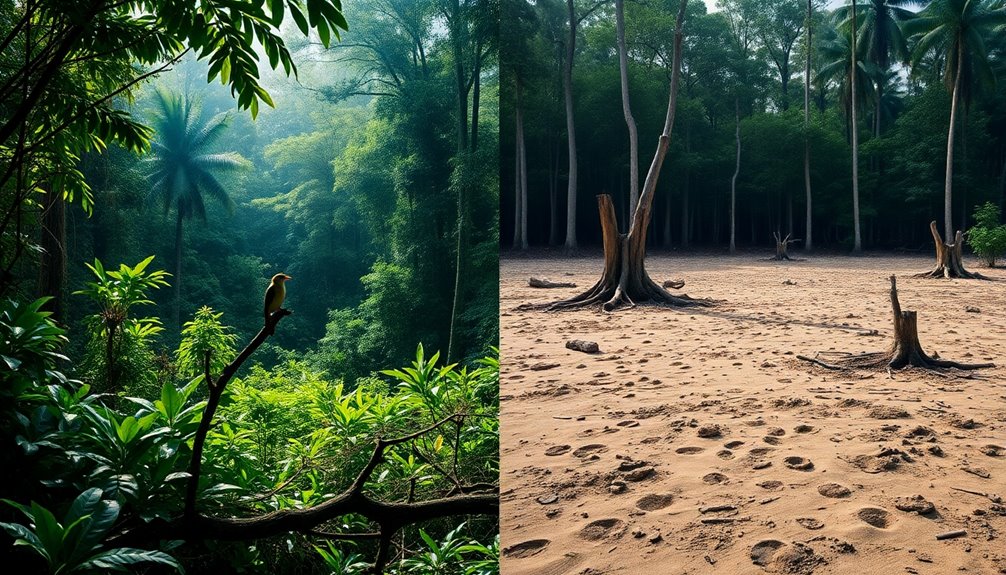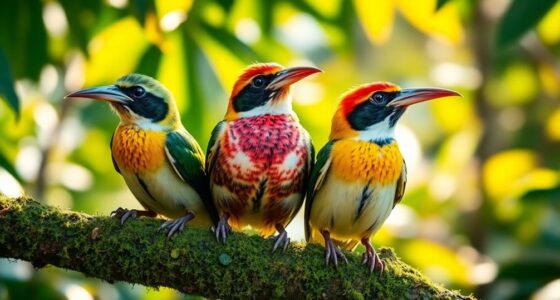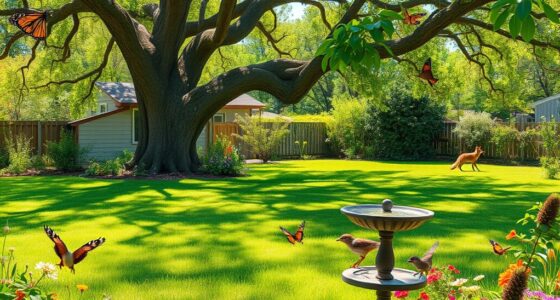Deforestation devastates biodiversity by destroying habitats, pushing countless species closer to extinction, and disrupting essential ecological processes. With forests being home to over half of the world's terrestrial species, their loss leads to a decline in species diversity and genetic variation. This creates isolated populations that struggle to adapt to environmental changes, raising the risk of biodiversity collapse. To understand the alarming impacts even further, consider the ongoing efforts and strategies for conservation.
Key Takeaways
- Deforestation causes habitat loss, leading to increased extinction risks for over 1 million species reliant on forest ecosystems.
- Fragmentation isolates populations, reducing genetic diversity crucial for species resilience and adaptation to environmental changes.
- The removal of forests disrupts ecological processes, destabilizing food chains and altering nutrient cycling essential for ecosystem health.
- Loss of key species due to deforestation hampers vital services like pollination and water purification, threatening overall ecosystem functionality.
- Deforestation exacerbates biodiversity collapse, with habitat loss exceeding 30% heightening extinction risks and necessitating immediate conservation efforts.
Understanding Deforestation and Its Causes
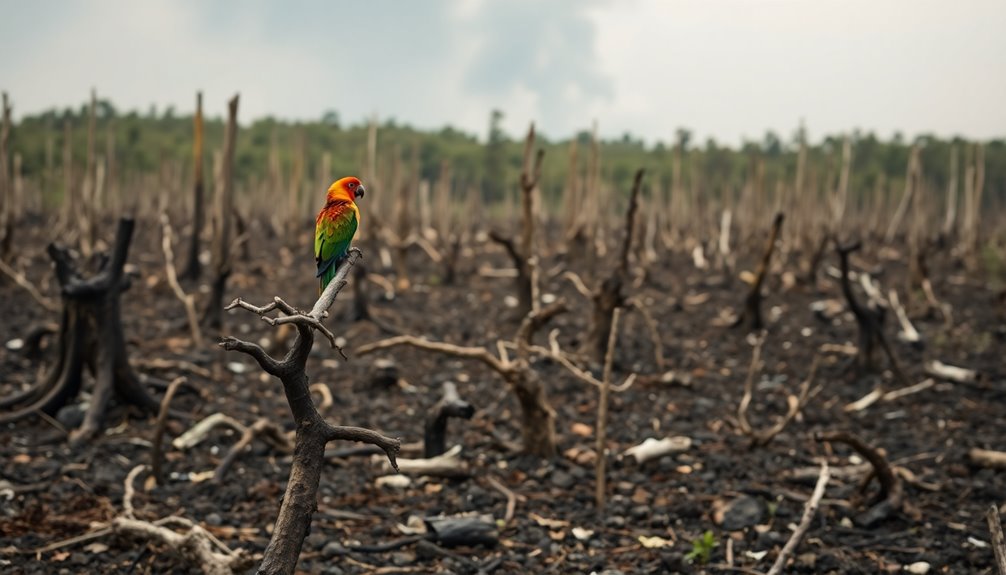
Deforestation occurs when trees are cleared from large forest areas, and it's largely driven by human activities like agriculture, logging, and urban development.
You may not realize that industrial agriculture accounts for about 85% of global deforestation, as land is cleared for crops and livestock, particularly in tropical regions. This agricultural land expansion leads to significant habitat loss, disrupting ecosystems and threatening biodiversity.
Logging operations, both legal and illegal, contribute to forest degradation and further destroy habitats. Additionally, mining activities, especially in places like the Amazon, exacerbate the problem by clearing land and polluting the environment.
Urbanization amplifies these effects, as cities expand, increasing the demand for land and resulting in further deforestation and habitat destruction.
The Role of Forests in Biodiversity
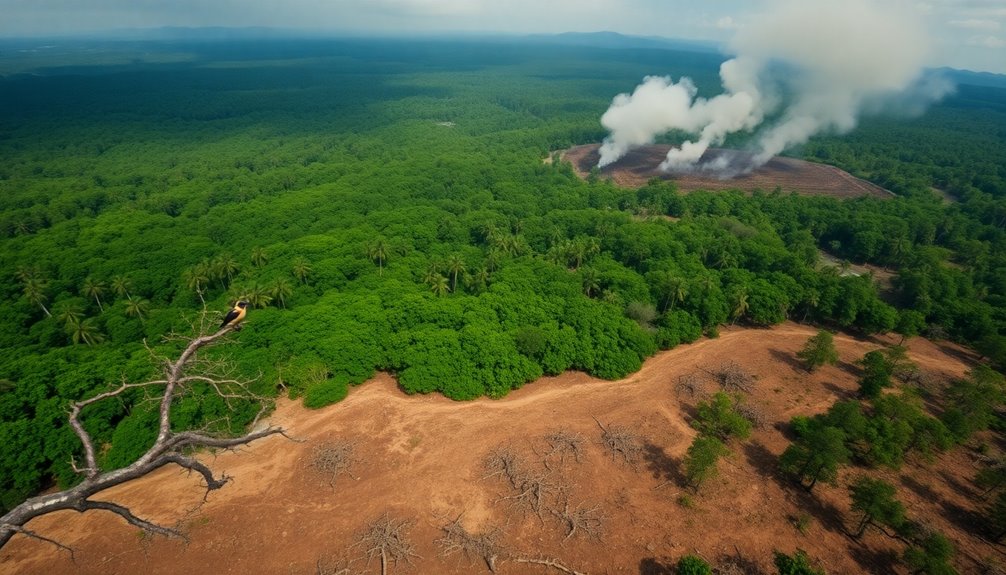
Forests are essential ecosystems that play an important role in supporting biodiversity across the globe. They cover nearly one-third of the Earth's land area, housing over half of the world's terrestrial species. Tropical forests, especially, are hotspots for biodiversity, with rich arrays of species.
- They support important ecological processes like nutrient cycling.
- High forest cover correlates with greater species richness.
- Deforestation affects these ecosystems, leading to biodiversity loss.
When forests are lost, it disrupts seed dispersal and isolates species, limiting gene pools. This fragmentation can undermine the resilience and adaptability of species in changing environments.
Protecting forests is critical for maintaining biodiversity and ensuring healthy ecosystems.
Loss of Habitat and Its Consequences
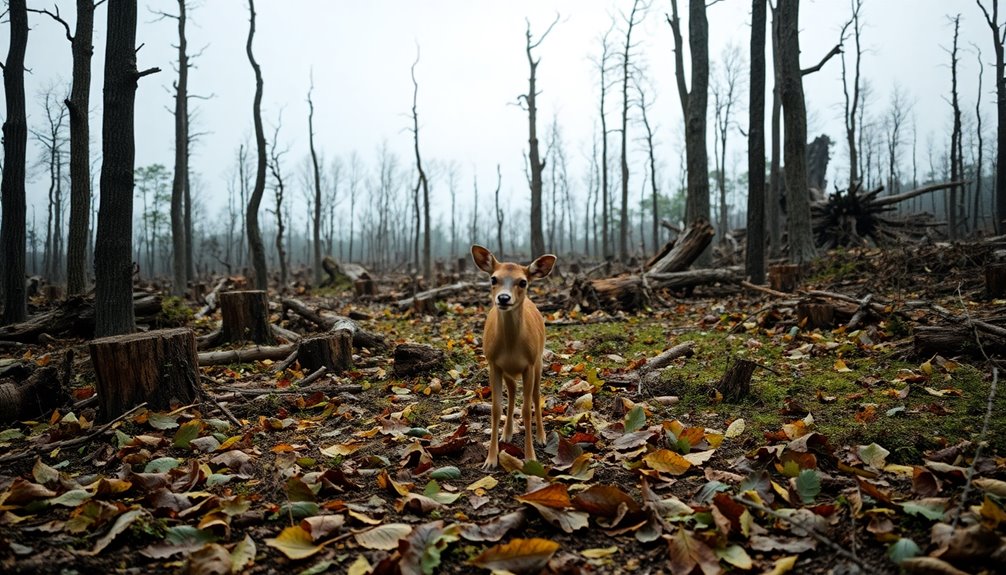
As ecosystems shrink, the consequences of habitat loss become increasingly apparent. Habitat destruction from deforestation leads to significant soil erosion, disrupting essential ecosystem services that support life.
With approximately 24.7 million acres of forest lost annually, biodiversity suffers greatly, increasing extinction risks for countless species reliant on these habitats. The removal of trees destabilizes food chains, contributing to ecosystem collapse and altering nutrient cycling, which is critical for soil fertility.
In addition, habitat loss reduces genetic diversity within species, weakening their resilience to environmental changes. High forest cover is crucial for maintaining species richness; once it dips below 30%, the likelihood of species extinction rises dramatically, threatening the delicate balance of our planet's ecosystems.
Decline in Species Diversity
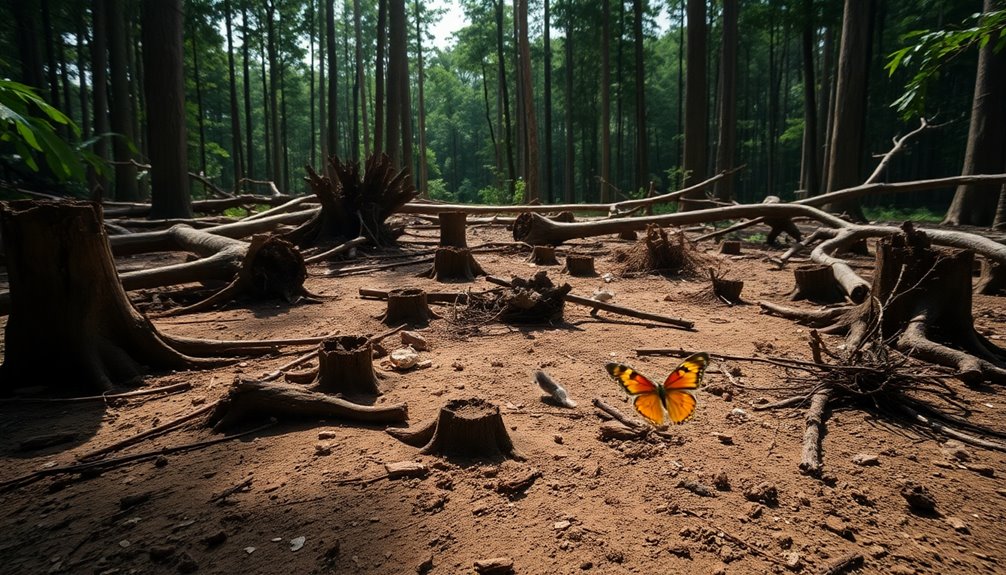
The ongoing loss of habitat is closely tied to a troubling decline in species diversity. Deforestation disrupts ecological processes, increasing extinction risks for over 1 million species worldwide, particularly in tropical areas.
As forest cover loss accelerates, the consequences become dire:
- Fragmentation isolates populations, limiting gene flow.
- Reduced habitat connectivity decreases genetic diversity.
- The removal of key species disrupts forest regeneration.
When forest cover drops below 30%, species extinction likelihood rises dramatically, impacting global biodiversity.
Each year, approximately 24.7 million acres of forest vanish, driving significant declines in species diversity and destabilizing ecosystems.
Without immediate action, the cascading effects of habitat loss will threaten not just species, but the delicate balance of nature itself.
Disruption of Food Chains and Food Webs
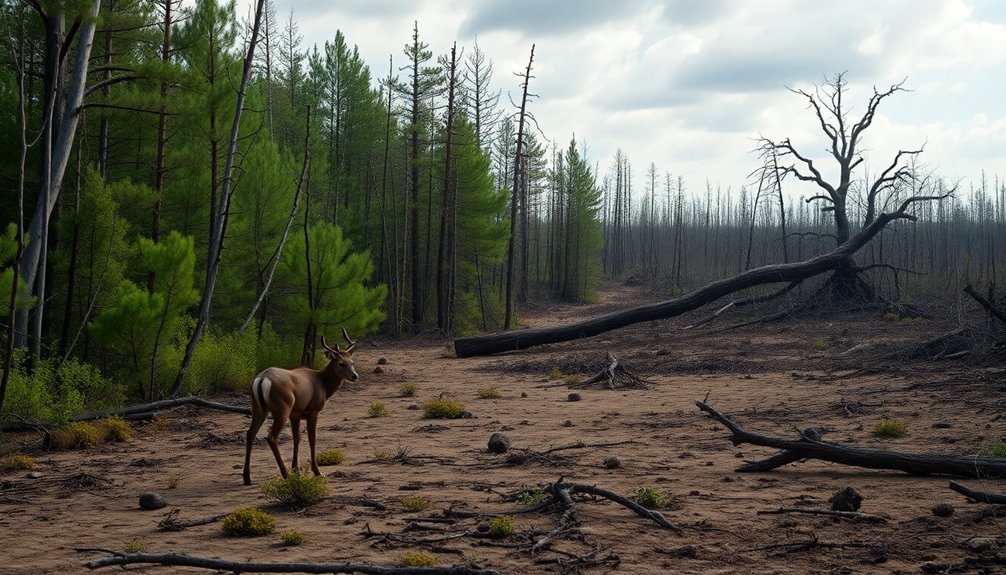
When deforestation occurs, it disrupts food chains and food webs, leading to significant ecological imbalances. The removal of primary producers like trees destabilizes ecosystem dynamics, affecting species composition and food availability.
Without adequate habitat, herbivores struggle to find food, impacting predator populations and creating a ripple effect throughout the food web. Fragmented forests isolate wildlife, limiting their ability to move, mate, and maintain genetic diversity.
This habitat loss can favor generalist species that thrive in disturbed areas while causing a decline in specialists. As a result, the balance of biodiversity shifts, jeopardizing the intricate relationships that sustain ecosystems.
Fundamentally, deforestation undermines the stability and resilience of food chains, threatening the survival of countless species.
Alteration of Nutrient Cycling

Deforestation not only disrupts food chains but also greatly alters nutrient cycling within ecosystems. When trees are removed, you're not just losing their physical presence; you're affecting essential processes that maintain soil fertility. This leads to a decline in biodiversity and impacts overall ecological health.
Consider these factors:
- The disruption of microbial communities hampers necessary nutrient processes.
- Decomposition rates of organic matter drop, reducing nutrient availability for plants.
- Increased soil erosion further depletes nutrients and degrades the ecosystem.
As you can see, deforestation triggers a cascade of ecological changes that compromise biological diversity, making it important to understand how these impacts ripple through nutrient cycling.
Impact on Genetic Diversity

When you consider the impact of deforestation, think about how habitat fragmentation affects genetic diversity.
As populations become isolated, gene flow decreases, limiting the potential for species to adapt and evolve.
This loss not only threatens individual species but also disrupts the balance of entire ecosystems.
Habitat Fragmentation Consequences
As habitat fragmentation isolates populations, it greatly impacts genetic diversity, which is essential for species resilience. When forest cover decreases, species struggle to thrive, leading to smaller, isolated groups that face increased extinction risks.
This isolation limits interbreeding and reduces adaptability, leaving populations vulnerable to diseases and environmental changes.
Key consequences include:
- Lower genetic variability, making species less adaptable.
- Increased extinction risks due to inbreeding.
- Loss of critical ecological interactions, affecting plant genetic diversity.
These factors highlight how habitat fragmentation threatens the long-term viability of species.
Reduced Gene Flow
Reduced gene flow poses a significant threat to genetic diversity, especially in fragmented habitats. As deforestation leads to habitat fragmentation, populations of species become isolated, limiting their gene flow.
This isolation increases the risk of inbreeding, which can reduce the fitness and adaptability of these populations over time. Large mammals, requiring expansive territories, are particularly vulnerable to reduced gene flow due to shrinking habitats.
The decline in genetic diversity makes it harder for species to adapt to environmental changes, heightening their extinction risk. Research shows that when forest cover drops below critical thresholds, the likelihood of local extinctions rises sharply, further impacting the essential gene flow necessary for healthy, resilient populations.
Speciation Limitations
Habitat fragmentation not only limits gene flow but also imposes significant speciation limitations. As deforestation continues, you'll notice that isolated species struggle to maintain genetic diversity, which is essential for their survival and adaptation.
This isolation can lead to:
- Increased inbreeding and reduced reproductive success
- Higher extinction rates for endangered species
- Vulnerability to diseases due to limited genetic variation
The smaller populations created by habitat fragmentation restrict the ability of species to evolve and adapt to environmental changes.
With declining genetic diversity, species face greater risks from stressors like climate change and habitat alterations. Ultimately, as genetic diversity diminishes, so does the resilience of these species, pushing many closer to extinction.
Long-term Risks to Ecosystem Functionality
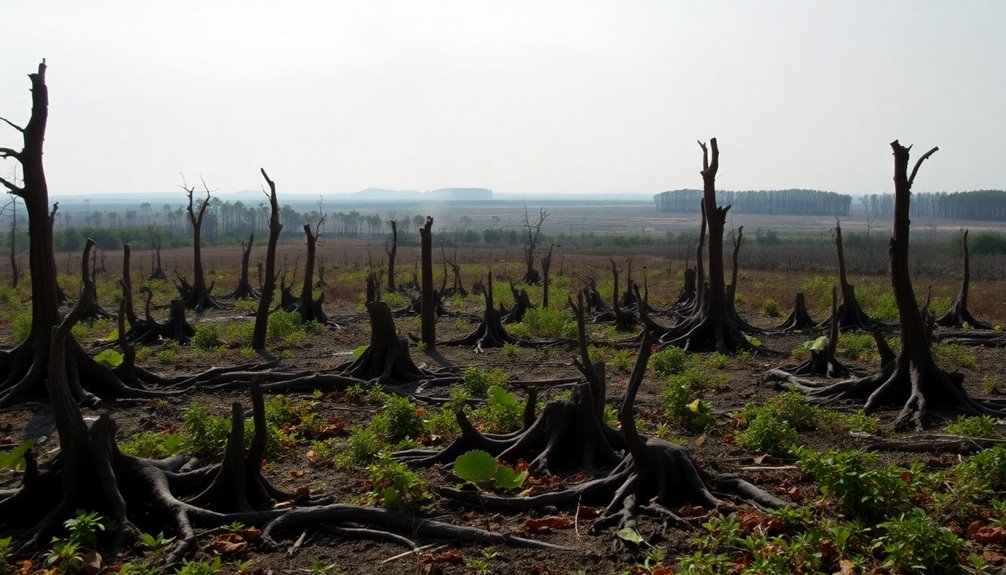
Deforestation puts you at risk of biodiversity collapse, threatening the delicate balance of ecosystems.
When key species disappear, essential ecological interactions break down, leading to disrupted services you rely on, like clean water and pollination.
Without effective management, these long-term risks can spiral out of control, compromising the functionality of the remaining environment.
Biodiversity Collapse Risks
As ecosystems continue to face the pressures of human activity, the risk of biodiversity collapse looms larger than ever. Deforestation drastically reduces species richness, leading to habitat loss and threatening essential ecosystem services. When habitat loss exceeds 30% of remaining forest cover, extinction risks soar.
Consider these alarming impacts:
- Loss of key species disrupts seed dispersal and nutrient cycling.
- Fragmented landscapes intensify biodiversity collapse.
- Without immediate conservation efforts, ecosystem functionality deteriorates.
The connection between deforestation and decreased biodiversity is undeniable. High forest cover supports greater species richness, while reduced densities of crucial seed dispersers hinder forest regeneration.
You must act now to mitigate these risks and protect our planet's invaluable ecosystems.
Disrupted Ecological Interactions
The loss of biodiversity doesn't just threaten individual species; it disrupts the intricate web of ecological interactions that sustain ecosystems.
Deforestation leads to habitat destruction, diminishing species populations and jeopardizing vital processes like seed dispersal and nutrient cycling. Without large herbivores, plant community diversity suffers, as these animals shape vegetation dynamics through grazing.
Additionally, altered dung beetle populations impair seed dispersal for zoochoric trees, hindering forest regeneration. Fragmented habitats increase species extinction risks, especially when forest cover drops below 30%.
These changes create cascading effects on ecosystem functionality, threatening the balance of life. To mitigate these long-term risks, effective management practices are essential in preserving biodiversity and maintaining healthy ecological interactions.
Impaired Ecosystem Services
While you mightn't realize it, the loss of forest cover directly undermines essential ecosystem services that support not just wildlife but human well-being too. Deforestation disrupts processes like nutrient cycling and seed dispersal, risking biodiversity and overall ecosystem functionality.
When key species vanish, the forest structure deteriorates, leading to:
- Reduced carbon storage capabilities
- Impaired water regulation
- Increased extinction risks for various species
As forest cover drops below critical thresholds, these cascading effects become more pronounced, compromising the intricate balance that sustains ecosystems.
Urgent research is crucial to understand the impacts of deforestation on different taxa and interactions, guiding effective management and restoration efforts to preserve our planet's invaluable biodiversity.
Mitigation Strategies for Biodiversity Conservation
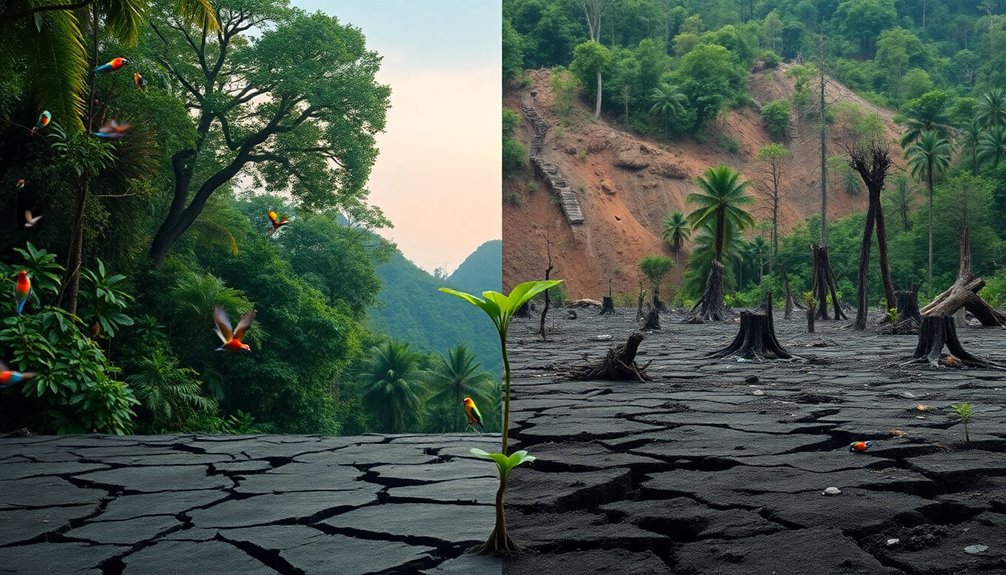
Mitigating the impact of deforestation on biodiversity requires a multifaceted approach that integrates various strategies.
You can focus on reforestation efforts to restore habitats and enhance ecosystem resilience, effectively reversing habitat loss.
Implementing sustainable forestry practices, like selective logging, minimizes environmental damage while preserving critical habitats.
Establishing protected areas with legal restrictions on logging guarantees the conservation of essential ecosystems that support diverse species.
Additionally, creating wildlife corridors facilitates species movement between fragmented habitats, promoting genetic diversity.
Engaging local communities in co-management models empowers them and fosters a long-term commitment to biodiversity conservation.
Case Studies: Deforestation in Global Hotspots

When you look at deforestation hotspots like the Amazon and Southeast Asia, the impacts are staggering.
The Amazon's rapid loss of forest not only endangers countless species but also threatens global climate stability.
Similarly, Southeast Asia's palm oil expansion has drastically reduced orangutan habitats, highlighting the urgent need for action.
Amazon Rainforest Deforestation Effects
As deforestation continues to ravage the Amazon rainforest, the consequences for its biodiversity become increasingly dire. The loss of approximately 24.7 million acres annually threatens countless species and disrupts essential ecosystem services.
You might be surprised to learn that:
- Habitat fragmentation isolates species, raising their extinction risk.
- The removal of key mammal seed dispersers hampers forest regeneration.
- Generalist species thrive, while specialized ones decline, leading to homogenized biodiversity.
These changes signal a significant tipping point for the Amazon Rainforest. Celebrity transformations in various regions have shown how ecosystems can be revitalized, yet the ongoing deforestation poses a greater threat.
If deforestation persists, we could witness large-scale dieback, drastically altering local climate patterns and diminishing biodiversity.
It's vital to recognize how interconnected these ecosystems are and the far-reaching impacts of our actions on them.
Southeast Asian Habitat Loss
Deforestation isn't just a problem in the Amazon; Southeast Asia faces its own severe challenges. Each year, around 6 million hectares of forest disappear, largely due to agricultural expansion for palm oil and rubber plantations.
This habitat loss has led to a staggering decline in biodiversity, threatening about 50% of terrestrial vertebrate species, including endemic species like the orangutan and Sumatran tiger. These animals become increasingly vulnerable as their habitats fragment, reducing genetic diversity and increasing disease risks.
Additionally, deforestation disrupts local water cycles, causing flooding and droughts. This impacts not only wildlife but also human communities that rely on these water resources, creating a cycle of ecological and social stress that needs urgent attention.
Frequently Asked Questions
How Does Deforestation Impact Biodiversity?
Deforestation impacts biodiversity by destroying habitats and isolating wildlife populations.
When trees are removed, you're not just losing trees; you're disrupting entire ecosystems. This leads to fewer species, as specialized animals struggle to survive in fragmented areas.
You might notice that essential ecological processes, like seed dispersal, falter, affecting plant communities.
Is Deforestation the Biggest Risk to Biodiversity Today?
You might be surprised to learn that deforestation has caused the loss of about 420 million hectares of forest since 1990.
This alarming trend is indeed one of the biggest risks to biodiversity today. As forests disappear, countless species lose their habitats, increasing extinction risks.
Fragmentation isolates populations, limits gene flow, and disrupts critical ecological processes.
If we don't act, we could face irreversible consequences for our planet's rich biodiversity.
How Does Deforestation Impact the Environment?
Deforestation impacts the environment considerably.
When trees are cut down, you're losing essential habitats for wildlife and disrupting ecosystems. This loss leads to poorer soil quality and altered water cycles, affecting both plants and animals.
You'll notice changes in local climates, increased greenhouse gas emissions, and reduced water quality.
Plus, habitat fragmentation isolates species, making it harder for them to survive.
Ultimately, it's a cycle that harms both nature and human communities.
How Does Deforestation Affect Biodiversity in the Amazon?
You might wonder how deforestation affects biodiversity, and the answer's alarming.
It disrupts habitats, fragments ecosystems, and pushes species toward extinction. By clearing forests, you're not just losing trees; you're losing entire communities of plants and animals that depend on each other.
As key species disappear, ecological balance falters, and regeneration slows. In the Amazon, this leads to severe consequences, risking a critical tipping point for an irreplaceable ecosystem.
Conclusion
In a world where forests are the lungs of our planet, their destruction chokes the life from ecosystems. Deforestation doesn't just strip away trees; it unravels the intricate tapestry of biodiversity that sustains us all. As species vanish and habitats crumble, we face a future where the balance of nature tilts dangerously. It's essential that we act now, embracing conservation strategies to protect our planet's rich biological heritage before it slips through our fingers like sand.
